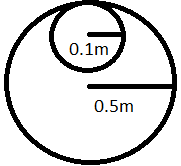Which of the Following Was Not an Example for a Continuous Distribution of Charge
This set of Physics Multiple Choice Questions & Answers (MCQs) focuses on "Continuous Charge Distribution".
1. How many electrons must be added to an isolated spherical conductor of radius 20cm to produce an electric field 1000N/C just outside the surface?
a) 2.77*1020
b) 2.77*1010
c) 1.77*1010
d) 5.4*1010
View Answer
Answer: b
Explanation: The electric field E = k \(\frac {Q}{r^2}\) where k=9*109 N m2 C-2 and Q is the charge of the sphere, r is the radius of the sphere. Therefore Q = \(\frac {E*r^2}{k}=\frac {1000*0.2^2}{9*10^9}\) = 4.44*10-9. Number of electrons required for this amount of charge is = \(\frac {4.44*10^{-9}}{1.602*10^{-19}}\) = 2.77*1010.
2. A circular annulus of inner radius r and outer radius R has a uniform charge density a. What will be the total charge on the annulus?
a) a*(R2-r2)
b) π*a*(R2-r2)
c) a*(R-r)
d) π*a* R2
View Answer
Answer: b
Explanation: Total surface area of the annulus = π*(R2-r2) because it has outer radius R and inner radius r. We know surface charge density is the amount of charge stored on the unit surface area. In this case, surface charge density is a. Therefore total charge on the annulus = π*a*(R2-r2).
3. What is the dimension of linear charge density?
a) [I T L-1]
b) [I T-1 L]
c) [I T L]
d) [I-1 T-1 L]
View Answer
Answer: a
Explanation: Linear charge density λ=\(\frac {Amount \, of\, charge}{Total \, length}\). The dimension of electric charge = [I T] and the dimension of length is [L]. Hence the dimension of linear-charge-density = [I T L-1]. In the case of surface charge density, the dimension is [I T L-2] because it means charge stored on the unit surface area.
4. A charge is distributed along an infinite curved line in space with linear charge distribution λ. What will be the amount of force on a point charge q kept at a certain distance from the line?
a) q∫\(\frac {\lambda}{r^2}\hat{r}\)dl
b) q∫\(\frac {\lambda}{r^2}\hat{r}\)dr
c) q∫\(\frac {\lambda}{r^3}\hat{r}\)dl
d) q∫\(\frac {\lambda}{r^2}\)
View Answer
Answer: a
Explanation: Let the point charge is situated at a distance r from a small part dl on the line. The charge stored in stat small part=λ.dl. The force due to that small part will be directed towards the unit vector \(\hat{r}\). Therefore, force on that charge due to the entire linear charge distribution=q∫\(\frac {\lambda}{r^2}\hat{r}\)dl.
5. The term 'volume charge density' is valid for a solid conducting sphere.
a) True
b) False
View Answer
Answer: b
Explanation: We know that in the case of any conducting material, the charge is always distributed on its outer surface instead of distribution throughout the material. Therefore, the word volume charge density doesn't make any sense in the case of the conducting sphere. Instead, we can use the term surface charge density.
6. A solid non conducting sphere of radius 1m carries a total charge of 10 C which is uniformly distributed throughout the sphere. Determine the charge density of the sphere.
a) 10 C/m3
b) 4.76 C/m3
c) 0.1 C/m3
d) 2.38 C/m3
View Answer
Answer: d
Explanation: Volume of the sphere = \(\frac {4}{3}\)πr3 where r is the radius of the sphere. Therefore, the charge density = \(\frac {total \, charge}{\frac {4}{3}\pi r^3}\). Now substituting the values, charge density = \(\frac {10}{\frac {4}{3}\pi r^3}\) = 2.38 C/m3. But if the sphere is conducting, we have to consider the surface charge density.
7. What is the charge density of the conducting plate shown below if a total charge of 10C is applied to it? Consider the bigger circle as a solid part and a smaller circle as a hollow part.

a) 13.26 C/m2
b) 5.25 C/m2
c) 0.7 C/m2
d) 17.28 C/m2
View Answer
Answer: a
Explanation: If the hollow part is cut out of the entire surface, the surface area will be=π(0.52 – 0.12)=0.754m2. As the plate is conducting, the electric charge will be uniformly distributed over the surface. Therefore, the charge density of the plate = \(\frac {10}{0.754}\)=13.26 C/m2.
Sanfoundry Global Education & Learning Series – Physics – Class 12.
To practice all areas of Physics, here is complete set of 1000+ Multiple Choice Questions and Answers.
Next Steps:
- Get Free Certificate of Merit in Physics - Class 12
- Participate in Physics - Class 12 Certification Contest
- Become a Top Ranker in Physics - Class 12
- Take Physics - Class 12 Tests
- Chapterwise Practice Tests: Chapter 1, 2, 3, 4, 5, 6, 7, 8, 9, 10
- Chapterwise Mock Tests: Chapter 1, 2, 3, 4, 5, 6, 7, 8, 9, 10

Manish Bhojasia, a technology veteran with 20+ years @ Cisco & Wipro, is Founder and CTO at Sanfoundry. He lives in Bangalore, and focuses on development of Linux Kernel, SAN Technologies, Advanced C, Data Structures & Alogrithms. Stay connected with him at LinkedIn.
Subscribe to his free Masterclasses at Youtube & technical discussions at Telegram SanfoundryClasses.
Source: https://www.sanfoundry.com/physics-questions-answers-continuous-charge-distribution/
0 Response to "Which of the Following Was Not an Example for a Continuous Distribution of Charge"
ارسال یک نظر